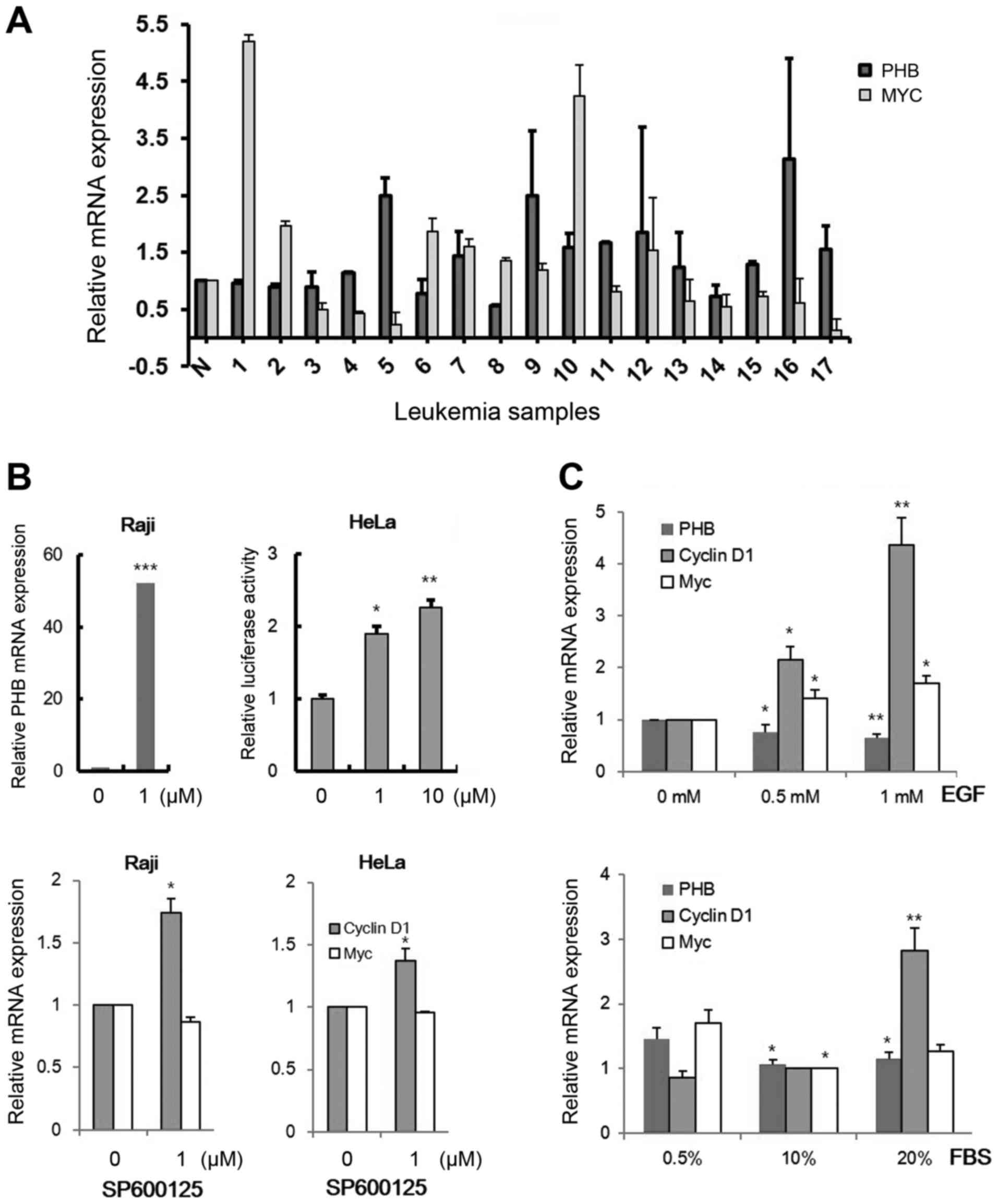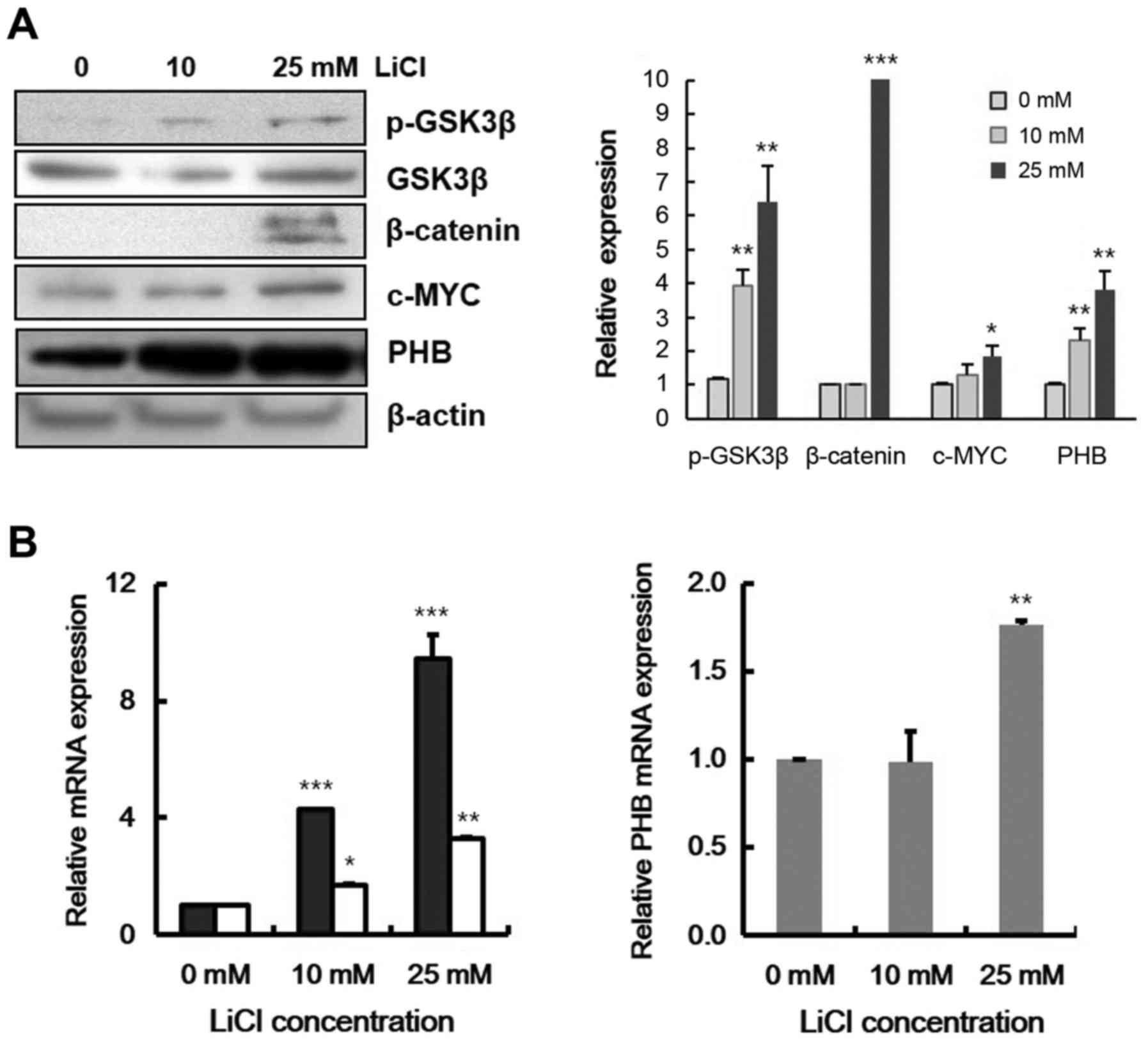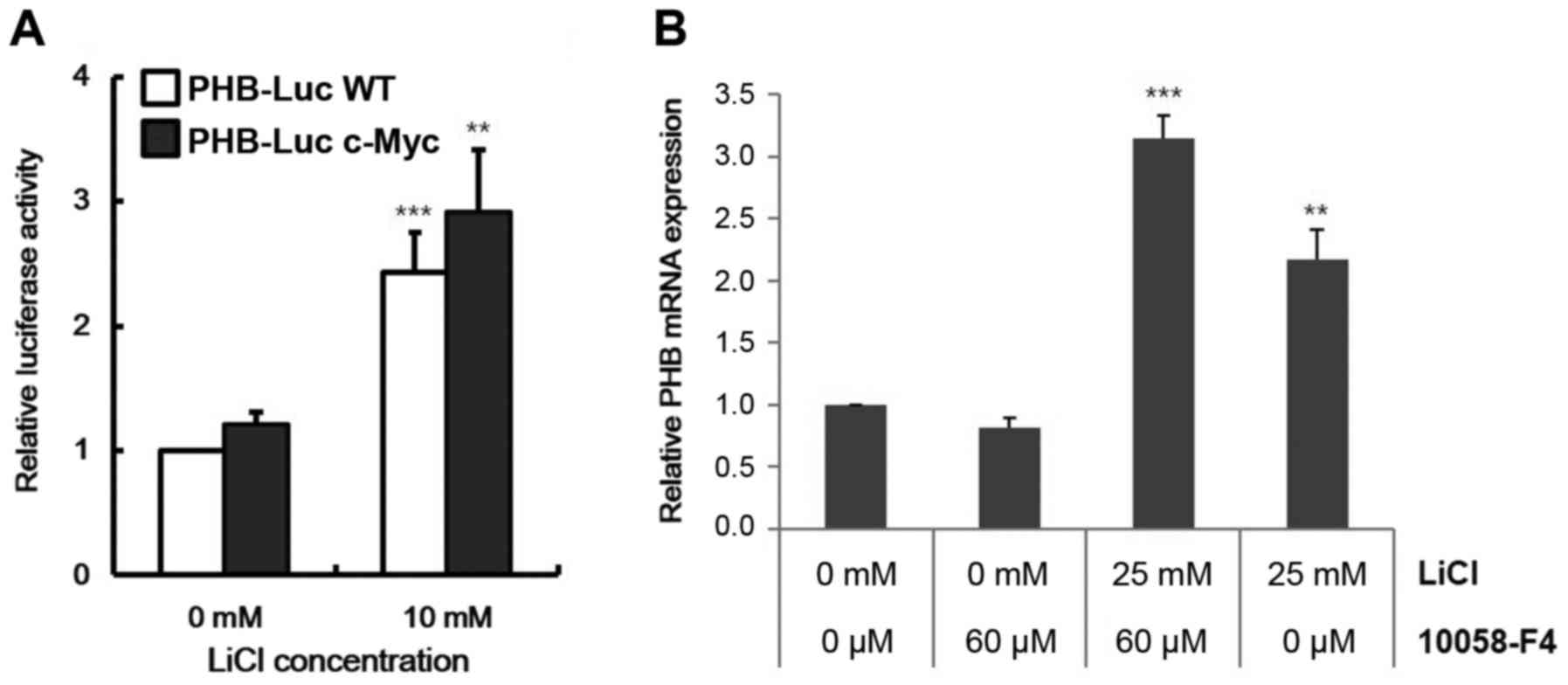|
1
|
McClung JK, Jupe ER, Liu XT and Dell'Orco
RT: Prohibitin: Potential role in senescence, development, and
tumor suppression. Exp Gerontol. 30:99–124. 1995. View Article : Google Scholar : PubMed/NCBI
|
|
2
|
Snedden WA and Fromm H: Characterization
of the plant homologue of prohibitin, a gene associated with
antiproliferative activity in mammalian cells. Plant Mol Biol.
33:753–756. 1997. View Article : Google Scholar : PubMed/NCBI
|
|
3
|
Loukas A and Maizels RM: Cloning and
characterisation of a prohibitin gene from infective larvae of the
parasitic nematode Toxocara canis. DNA Seq. 9:323–328. 1998.
View Article : Google Scholar : PubMed/NCBI
|
|
4
|
Eveleth DD Jr and Marsh JL: Sequence and
expression of the Cc gene, a member of the dopa decarboxylase gene
cluster of Drosophila: Possible translational regulation. Nucleic
Acids Res. 14:6169–6183. 1986. View Article : Google Scholar : PubMed/NCBI
|
|
5
|
Sato T, Saito H, Swensen J, Olifant A,
Wood C, Danner D, Sakamoto T, Takita K, Kasumi F, Miki Y, et al:
The human prohibitin gene located on chromosome 17q21 is mutated in
sporadic breast cancer. Cancer Res. 52:1643–1646. 1992.PubMed/NCBI
|
|
6
|
Back JW, Sanz MA, De Jong L, De Koning LJ,
Nijtmans LG, De Koster CG, Grivell LA, Van Der Spek H and Muijsers
AO: A structure for the yeast prohibitin complex: Structure
prediction and evidence from chemical crosslinking and mass
spectrometry. Protein Sci. 11:2471–2478. 2002. View Article : Google Scholar : PubMed/NCBI
|
|
7
|
Nijtmans LG, Artal SM, Grivell LA and
Coates PJ: The mitochondrial PHB complex: Roles in mitochondrial
respiratory complex assembly, ageing and degenerative disease. Cell
Mol Life Sci. 59:143–155. 2002. View Article : Google Scholar : PubMed/NCBI
|
|
8
|
Sharma A and Qadri A: Vi polysaccharide of
Salmonella typhi targets the prohibitin family of molecules in
intestinal epithelial cells and suppresses early inflammatory
responses. Proc Natl Acad Sci USA. 101:pp. 17492–17497. 2004;
View Article : Google Scholar : PubMed/NCBI
|
|
9
|
Kolonin MG, Saha PK, Chan L, Pasqualini R
and Arap W: Reversal of obesity by targeted ablation of adipose
tissue. Nat Med. 10:625–632. 2004. View
Article : Google Scholar : PubMed/NCBI
|
|
10
|
Rajalingam K and Rudel T: Ras-Raf
signaling needs prohibitin. Cell Cycle. 4:1503–1505. 2005.
View Article : Google Scholar : PubMed/NCBI
|
|
11
|
Mishra S, Murphy LC, Nyomba BL and Murphy
LJ: Prohibitin: A potential target for new therapeutics. Trends Mol
Med. 11:192–197. 2005. View Article : Google Scholar : PubMed/NCBI
|
|
12
|
Mishra S, Murphy LC and Murphy LJ: The
prohibitins: Emerging roles in diverse functions. J Cell Mol Med.
10:353–363. 2006. View Article : Google Scholar : PubMed/NCBI
|
|
13
|
Wang S, Fusaro G, Padmanabhan J and
Chellappan SP: Prohibitin co-localizes with Rb in the nucleus and
recruits N-CoR and HDAC1 for transcriptional repression. Oncogene.
21:8388–8396. 2002. View Article : Google Scholar : PubMed/NCBI
|
|
14
|
Fusaro G, Dasgupta P, Rastogi S, Joshi B
and Chellappan S: Prohibitin induces the transcriptional activity
of p53 and is exported from the nucleus upon apoptotic signaling. J
Biol Chem. 278:47853–47861. 2003. View Article : Google Scholar : PubMed/NCBI
|
|
15
|
Wang S, Nath N, Adlam M and Chellappan S:
Prohibitin, a potential tumor suppressor, interacts with RB and
regulates E2F function. Oncogene. 18:3501–3510. 1999. View Article : Google Scholar : PubMed/NCBI
|
|
16
|
Joshi B, Ko D, Ordonez-Ercan D and
Chellappan SP: A putative coiled-coil domain of prohibitin is
sufficient to repress E2F1-mediated transcription and induce
apoptosis. Biochem Biophys Res Commun. 312:459–466. 2003.
View Article : Google Scholar : PubMed/NCBI
|
|
17
|
Wang S, Zhang B and Faller DV: BRG1/BRM
and prohibitin are required for growth suppression by estrogen
antagonists. EMBO J. 23:2293–2303. 2004. View Article : Google Scholar : PubMed/NCBI
|
|
18
|
DiRenzo J, Shang Y, Phelan M, Sif S, Myers
M, Kingston R and Brown M: BRG-1 is recruited to
estrogen-responsive promoters and cooperates with factors involved
in histone acetylation. Mol Cell Biol. 20:7541–7549. 2000.
View Article : Google Scholar : PubMed/NCBI
|
|
19
|
He B, Feng Q, Mukherjee A, Lonard DM,
DeMayo FJ, Katzenellenbogen BS, Lydon JP and O'Malley BW: A
repressive role for prohibitin in estrogen signaling. Mol
Endocrinol. 22:344–360. 2008. View Article : Google Scholar : PubMed/NCBI
|
|
20
|
Artal-Sanz M, Tsang WY, Willems EM,
Grivell LA, Lemire BD, van der Spek H and Nijtmans LG: The
mitochondrial prohibitin complex is essential for embryonic
viability and germline function in Caenorhabditis elegans. J Biol
Chem. 278:32091–32099. 2003. View Article : Google Scholar : PubMed/NCBI
|
|
21
|
Arraztoa JA, Zhou J, Marcu D, Cheng C,
Bonner R, Chen M, Xiang C, Brownstein M, Maisey K, Imarai M, et al:
Identification of genes expressed in primate primordial oocytes.
Hum Reprod. 20:476–483. 2005. View Article : Google Scholar : PubMed/NCBI
|
|
22
|
Coates PJ, Nenutil R, McGregor A, Picksley
SM, Crouch DH, Hall PA and Wright EG: Mammalian prohibitin proteins
respond to mitochondrial stress and decrease during cellular
senescence. Exp Cell Res. 265:262–273. 2001. View Article : Google Scholar : PubMed/NCBI
|
|
23
|
Ryu JW, Kim HJ, Lee YS, Myong NH, Hwang
CH, Lee GS and Yom HC: The proteomics approach to find biomarkers
in gastric cancer. J Korean Med Sci. 18:505–509. 2003. View Article : Google Scholar : PubMed/NCBI
|
|
24
|
Xu Z, Wu J and Zha X: Up-regulation of
prohibitin 1 is involved in the proliferation and migration of
liver cancer cells. Sci China Life Sci. 54:121–127. 2011.
View Article : Google Scholar : PubMed/NCBI
|
|
25
|
Menssen A and Hermeking H:
Characterization of the c-MYC-regulated transcriptome by SAGE:
Identification and analysis of c-MYC target genes. Proc Natl Acad
Sci USA. 99:pp. 6274–6279. 2002; View Article : Google Scholar : PubMed/NCBI
|
|
26
|
Fusaro G, Wang S and Chellappan S:
Differential regulation of Rb family proteins and prohibitin during
camptothecin-induced apoptosis. Oncogene. 21:4539–4548. 2002.
View Article : Google Scholar : PubMed/NCBI
|
|
27
|
Li QF, Liang Y, Shi SL, Liu QR, Xu DH,
Jing GJ, Wang SY and Kong HY: Localization of prohibitin in the
nuclear matrix and alteration of its expression during
differentiation of human neuroblastoma SK-N-SH cells induced by
retinoic acid. Cell Mol Neurobiol. 31:203–211. 2011. View Article : Google Scholar : PubMed/NCBI
|
|
28
|
Gilliland DG, Jordan CT and Felix CA: The
molecular basis of leukemia, Hematology Am Soc Hematol Educ Progam.
2004.80–97
|
|
29
|
Hu Y, Chen Y, Douglas L and Li S:
Beta-catenin is essential for survival of leukemic stem cells
insensitive to kinase inhibition in mice with BCR-ABL-induced
chronic myeloid leukemia. Leukemia. 23:109–116. 2009. View Article : Google Scholar : PubMed/NCBI
|
|
30
|
Zhao C, Blum J, Chen A, Kwon HY, Jung SH,
Cook JM, Lagoo A and Reya T: Loss of beta-catenin impairs the
renewal of normal and CML stem cells in vivo. Cancer Cell.
12:528–541. 2007. View Article : Google Scholar : PubMed/NCBI
|
|
31
|
Müller-Tidow C, Steffen B, Cauvet T,
Tickenbrock L, Ji P, Diederichs S, Sargin B, Köhler G, Stelljes M,
Puccetti E, et al: Translocation products in acute myeloid leukemia
activate the Wnt signaling pathway in hematopoietic cells. Mol Cell
Biol. 24:2890–2904. 2004. View Article : Google Scholar : PubMed/NCBI
|
|
32
|
Siapati EK, Papadaki M, Kozaou Z, Rouka E,
Michali E, Savvidou I, Gogos D, Kyriakou D, Anagnostopoulos NI and
Vassilopoulos G: Proliferation and bone marrow engraftment of AML
blasts is dependent on β-catenin signalling. Br J Haematol.
152:164–174. 2011. View Article : Google Scholar : PubMed/NCBI
|
|
33
|
Gururajan M, Chui R, Karuppannan AK, Ke J,
Jennings CD and Bondada S: c-Jun N-terminal kinase (JNK) is
required for survival and proliferation of B-lymphoma cells. Blood.
106:1382–1391. 2005. View Article : Google Scholar : PubMed/NCBI
|
|
34
|
Artal-Sanz M and Tavernarakis N: Opposing
function of mitochondrial prohibitin in aging. Aging (Albany, NY).
2:1004–1011. 2010. View Article : Google Scholar
|
|
35
|
Yu K, Ravera CP, Chen YN and McMahon G:
Regulation of Myc-dependent apoptosis by p53, c-Jun N-terminal
kinases/stress-activated protein kinases, and Mdm-2. Cell Growth
Differ. 8:731–742. 1997.PubMed/NCBI
|
|
36
|
Noguchi K, Yamana H, Kitanaka C, Mochizuki
T, Kokubu A and Kuchino Y: Differential role of the JNK and p38
MAPK pathway in c-Myc- and s-Myc-mediated apoptosis. Biochem
Biophys Res Commun. 267:221–227. 2000. View Article : Google Scholar : PubMed/NCBI
|
|
37
|
Jauregui MP, Sanchez SR, Ewton AA, Rice L,
Perkins SL, Dunphy CH and Chang CC: The role of beta-catenin in
chronic myeloproliferative disorders. Hum Pathol. 39:1454–1458.
2008. View Article : Google Scholar : PubMed/NCBI
|
|
38
|
Jost E, Gezer D, Wilop S, Suzuki H, Herman
JG, Osieka R and Galm O: Epigenetic dysregulation of secreted
Frizzled-related proteins in multiple myeloma. Cancer Lett.
281:24–31. 2009. View Article : Google Scholar : PubMed/NCBI
|
|
39
|
Stambolic V, Ruel L and Woodgett JR:
Lithium inhibits glycogen synthase kinase-3 activity and mimics
wingless signalling in intact cells. Curr Biol. 6:1664–1668. 1996.
View Article : Google Scholar : PubMed/NCBI
|
|
40
|
Woodlock TJ, Bethlendy G and Segel GB:
Prohibitin expression is increased in phorbol ester-treated chronic
leukemic B-lymphocytes. Blood Cells Mol Dis. 27:27–34. 2001.
View Article : Google Scholar : PubMed/NCBI
|
|
41
|
Wang Y, Krivtsov AV, Sinha AU, North TE,
Goessling W, Feng Z, Zon LI and Armstrong SA: The Wnt/beta-catenin
pathway is required for the development of leukemia stem cells in
AML. Science. 327:1650–1653. 2010. View Article : Google Scholar : PubMed/NCBI
|
|
42
|
Kim Y, Thanendrarajan S and Schmidt-Wolf
IGH: Wnt/β-catenin: A new therapeutic approach to acute myeloid
leukemia, Leuk Res Treatment. 2011.428960
|
|
43
|
Ashihara E, Takada T and Maekawa T:
Targeting the canonical Wnt/β-catenin pathway in hematological
malignancies. Cancer Sci. 106:665–671. 2015. View Article : Google Scholar : PubMed/NCBI
|
|
44
|
Chim CS, Chan WW, Pang A and Kwong YL:
Preferential methylation of Wnt inhibitory factor-1 in acute
promyelocytic leukemia: An independent poor prognostic factor.
Leukemia. 20:907–909. 2006. View Article : Google Scholar : PubMed/NCBI
|
|
45
|
Xu DH, Tang J, Li QF, Shi SL, Chen XF and
Liang Y: Positional and expressive alteration of prohibitin during
the induced differentiation of human hepatocarcinoma SMMC-7721
cells. World J Gastroenterol. 14:5008–5014. 2008. View Article : Google Scholar : PubMed/NCBI
|
|
46
|
Zhao CH and Li QF: Altered profiles of
nuclear matrix proteins during the differentiation of human gastric
mucous adenocarcinoma MGc80-3 cells. World J Gastroenterol.
11:4628–4633. 2005. View Article : Google Scholar : PubMed/NCBI
|
|
47
|
Feng W, Webb P, Nguyen P, Liu X, Li J,
Karin M and Kushner PJ: Potentiation of estrogen receptor
activation function 1 (AF-1) by Src/JNK through a serine
118-independent pathway. Mol Endocrinol. 15:32–45. 2001. View Article : Google Scholar : PubMed/NCBI
|
|
48
|
Sun L, Liu L, Yang XJ and Wu Z: Akt binds
prohibitin 2 and relieves its repression of MyoD and muscle
differentiation. J Cell Sci. 117:3021–3029. 2004. View Article : Google Scholar : PubMed/NCBI
|













